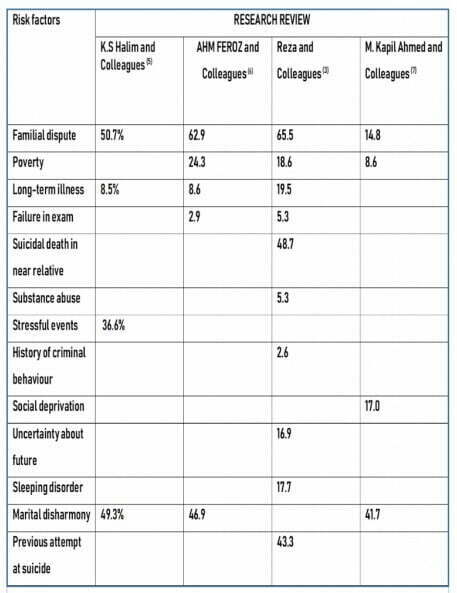Last updated on August 21st, 2022 at 10:51 am
PREMEDITATED AND COMPULSIVE SUICIDE WHICH IS RESPONSIBLE FOR TAKING 8000,000 LIVES ANNUALLY GAVE RISE TO A NEW CONCERN THAT INVOLVES VARIOUS SUICIDE RISK FACTORS. THE WORSENING MENTAL HEALTH REQUIRES REDRESS.
In the Netflix TV series 1000 Ways to Die the narrator narrates, “death is everywhere. Most of us try to avoid it, others cannot get out of their ways. Every day we fight a new war against germs, toxic, injury, illness, and catastrophe. There are a lot of ways to wind up deaths. In fact, we survived it all is a miracle. Because every day we live we face 1,000 ways to die”. Suicide is one of them which relates to numerous risk factors.
Life is disappointing
Tokyo Story-1953
Bollywood’s controversial movie Jism-2 starts with a message from the Bible that, “life on earth is a warfare”. Indeed life, living and struggle for survival getting even tougher every day passes. Darwin’s ‘survival of the fittest’ is no longer bears any significance in real life as life and living is a matter of ‘Survival of the luckiest’.
That constant struggle for survival, adaptation, peer pressure, coping up with demand increasingly becoming costlier as the prospect of luxury is multiplying every day. The unmet expectation, loveless exaggerative relations, separation from loved ones, the pain of illness, hopelessness, infidelity, lack of moderation and unfulfilled greed facilitate suicidal intend in the human mind. Over the ages, suicide has become of the 1000 ways to die. To be able to avoid the 1000 ways of being killed ultimately makes us wonder whether it is by chance or privilege of being able to pay for fortunes that makes us alive.
Being number one, Ischemic Heart Disease that killed 8,756,006 people worldwide in 2015, according to the Center for Disease Control and Prevention suicide is still the number 10 cause of death in the United States. Suicide ranked Third as a cause of death for teens in 2013 of which depression, hopelessness, and anxiety are the most common causes.
Having a 12.70 death rate from suicide the United States still stands at 47 in the Global ranking. Killing nearly 800,000 people every year, which is 1 person in every 40-second suicide, WHO says suicide it is responsible for 1.4% of all death that occurs around the world. Acceding to WHO suicide is the 18th leading cause of death worldwide of which 79% of incidents occur in low and middle-income countries.
Meantal health and Bangladesh: Our share of suicide
Responsible for 34.64 death rate per 100,000 Sri Lanka remains on top of 183 counties with the lowest rate of 0.00 in Antigua and Barbados, combined. Regarding the rate of the suicide Global Raking Pakistan 2.46, India 16.05, Nepal 7.05, Bangladesh 5.98 (which was 11.96 in 1990), Afghanistan 6.92, Bhutan 12.16, Maldives 10.83 China 8.53 death rate in per 100,000 Bangladesh is placed at 139 while Pakistan is at 177, pairing better than any other countries mentioned. Sri Lanka, Guyana, Mongolia, Kazakhstan, Suriname, Cote De Voire, Lithuania, Equatorial Guinea, Angola, and South Africa are the top-tenner.
As per Suicide.org, 90% of people who died by suicide have a mental illness, and depression is the most common one. Stroke being the primary factor of death, suicide is the 23rd cause of death in Bangladesh. According to a report 8,879 or 1.13% of total death documented from suicide every year.
During the COVID-19 pandemic, most university students suffer from mental health in Bangladesh. The Achol Foundation survey says that the share of the sufferers is 84.6 per cent, of which most are women. The survey was conducted on 2,55o university students of whom 80.38 male and 87.30 per cent female students are found to be suffering from mental health problems. Overall, 84 per cent of students are suffering from mental health.
A study conducted by three authors on 166,766 households in Bangladesh reports that more than 10,000 people die every year due to suicide. The researcher in the study says, “It was found that more than 38% of the population who died from suicide were housewives. Farmers were the second-highest proportion constituting 20% of the total suicide deaths. About 9%of the cases were students and all of the students were female.”
They further found that “Service holders, businesspeople and day labourers were the other professions identified among the suicide victims in this study. 10% were unemployed. The overall rate of suicide in Bangladesh was found to be 7.3 per 100,000 population per year. The suicide risk was found to be slightly higher among females compared to males”.1
Until the French Revolution, suicide was considered a serious offence in almost all Western European countries from the Middle Ages. England was the last nation of the countries to accept suicide in 1961. But many counties still consider suicide as a crime, in a country like Singapore. Nevertheless, in the lower-middle-income countries like Bangladesh where Muslims are the predominant majority suicide many times remains undisclosed for the accurate demography because of social and religious stigmatization.
Of the prevalent reasons for self-harming or suicide among teenagers divorce of parents, domestic violence, educational failure, despondency or feeling worthlessness, peer rejection, substance abuse, the demise of loved ones are frequent. Sharmin Salam and her colleagues observed that “Demographic and health surveillance in two rural sub-districts of Bangladesh between 2004 and 2010 revealed that the most common cause of death for young adults (aged 15–49) was injury (23.5%) with suicide accounting for 11.9%.
There is a need for recent population-based data that could be used to define the burden and epidemiology of suicide in Bangladesh, and to consequently address interventions for reducing rates of fatal and non-fatal suicidal behaviour in Bangladesh”.2
Of the total 1653 recorded cases in 2012 of suicide in the Chittagong division, the researchers found that “Majority 128 (78%) were of 15-45 years age group. Female predominant 84 (51%). Married 108 (65%).Muslims 125 (76%). The majority 104 (63%) of the victims were poorly educated (Class 0-X). Among the victims: Housewife 57 (35%) Service holder 49(30%) and Day labourer 38(23%)”. They recorded that 44% of the incidences occurred because of the family feud, while familial humiliation 16%, mental disorder 15%, love affairs 08.0%, sexual assault and social stigma 17%.
Domestic conflict: a major risk factor
Of the 2304 subjects of the study of the researchers aiming to investigate the potential risk factor of suicide or suicidal attempts and the specific objectives, they found that 23.9% personal problem, 18.6 % economic hardship, poor academic performance 5.3 %, chronic disease 19.5 %, uncertainty about future 15.9 %, Impulsivity 10.6%, Sleeping disturbance 17.7%. Of the familial predisposition, 65.5% incidences are about domestic conflicts and 46.9% marital disharmony.
Research conducted by a professor of psychiatry of Bangabandhu Sheikh Mujib Medical University, Dhaka, says, “The nuptial status varies from the western societies where marriage is protective, but in Bangladesh, it may be a significant source of stress as because of early age at marriage, lack of autonomy in choosing a partner, the joint family system and such.
 Mental health in Bangladesh: Common suicide risk factors in Bangladesh 5, 6, 7
Mental health in Bangladesh: Common suicide risk factors in Bangladesh 5, 6, 7
According to National Centre for Injury Prevention and Control, USA, 41,149 suicide incidences took place in 2013 at the rate of 12.6 persons per 100,000 which is equal to 113 each day and 12 incidences per minute.
According to their estimation, 51 billion USD medical and work-related loss has been detected. 17.0 % of students seriously considered committing suicide in the preceding 12 months, 22.4 and 11.6 % were females and males respectively. 9.3 million Adults people were reported to have suicidal thoughts wherein the female portion of the population have shown to entertain suicidal thought than males in the USA.8
It is notable that contrary to the global pattern, the suicide rate for females in all age groups (8.2 per 100,000 populations) is higher than in males (6.5 per 100,000 population) in Bangladesh too. Adolescent females (10 – 19 years) were found to be the most vulnerable with the rate of suicide of around 20 per 100,000 in rural areas. These rates resemble the age-sex specific suicide risk in Nepal.
The suicide rate in Bangladesh is 17-fold higher in the rural population than in urban areas. Suicide is a neglected and under-attended public health problem in Bangladesh with a few research and paucity of literature. Nationwide survey conduction and the establishment of national suicide surveillance are now a time demanded step as the review revealed Bangladesh as a high suicidal rate country in Asia.9
Mental health: when money is a primal indicator it
Psychological dissatisfaction from feeling inadequacy, discontent and material greed; academic and professional failures, parental desperation of children’s secured future, the excessive economic burden–often as debts, conspicuous consumption of modern luxury, conjugal infidelity, excessive futuristic preoccupation, and chronic disease are responsible for mental morbidity. The situations and recurrence are so frequent that it feels as if there is no escape from the trap anyway.
The more the modern civilization ponders in even more technological merit and advancement, the more the mediums of deaths are being discovered. As is observed in the study subjects 48.7% of risk factor are linked to suicidal attempts of any relative. It is, therefore, self-evidential that the trends of self-killing are passed on to the next generation by the one who makes himself a victim of self-killing.
The questions: why should self-killing be a solution to one’s existing problems? Does the social perspective about how we live matter? Or, how can suicide be a way to escape problems instead of solving them? Is it our inability to realize our purpose in life or simply the inability to train our brain?
The inability to control tumultuous situations, failure to gain expected success and achievement, fear of losing one’s capabilities of survival, preferential supremacy over the feeble ones, and the weaker ones’ predisposition to retaliate on stronger, lacking a coping mechanism to compete for all lead to psychological apprehension which, if it continues to mount, leads to greater depression, self-killing, as the conclusive stage.
Nobel Prize winner French surgeon and biologist Dr Alexis Carrel said, “Those who keep the peace of their inner selves in the midst of the tumult of the modern city are immune from nervous diseases”. When the cruel Chinese warlords wanted to torture their prisoners, they would tie their prisoners’ hand and foot and put them under a bag of water that constantly dripped … dripped … dripped … day and night.
Those who keep the peace of their inner selves in the midst of the tumult of the modern city are immune from nervous diseases
-Dr. Alexis Carrel
These drops of water constantly falling on the head finally became like the sound of hammer blows and drives men insane. This same method of torture was used during the Spanish Inquisition and in German concentration camps under Hitler. Worry is like the constant drip, drip, drip of water; and the constant drip, drip, drip of worry often drives men to insanity and suicide.

Mental health: Inspiration must come from within
The US Navy Admiral Ernest J. King once said, “when a ship has been sunk I can’t bring it up. If it is going to be sunk, I can’t stop it. I can use my time much better working on tomorrow’s problem than by fretting about yesterdays. Besides, if I let those things get me, I wouldn’t last long”. Likewise, there are numerous things that surround us that we have hardly any control of.
But we still hold on to the things that ultimately perish us. Notwithstanding, Positivity, optimism, gratefulness, good thinking and hopefulness always have causes and effects that lead to logical, constructive—instead of destructive—planning while bad perspectives of our circumstances lead to tension, anxiety and nervous breakdown.
Similarly, philosopher Thomas Carlyle said, “Our main objective is not to see what lies dimly at a distance, but to do what lies clearly at hand”. Battled with depression, drug, and alcohol addiction throughout his life, Robin Williams, Hollywood’s one of the most celebrated actors of the time, commits suicide in 2014. Gaining everything perfectly arranged guarantees a worry-free life.
By overruling the possibility of an accidental overdose of drugs, Marilyn Monroe’s death by suicide came as a surprise to the world. Her personal physician said she was ‘prone to severe fear and frequent depressions’. Let us conclude with a citation from Dale Carnegie, “Shut off the future as tightly as the past.
The future is today. There is no tomorrow. The day of man’s salvation is now. Waste of energy, mental distress, nervous worries dog the steps of a man who is anxious about the future. Roman poet Horace said,
Happy the man, and happy he alone,
Horace
He, who can call to-day his own:
He who, secure within, can say:”
“To-morrow, do thy worst, for I have liv’d to-day”.
Rohingya crisis in Bangladesh and its global political victim
Works Cited:
- Suicide Kills More Than 10,000 People Every Year in Bangladesh. Saidur Rahman Mashreky, A.K.M. Fazlur Rahman & Aminur Rahman. ↩
- The Burden of Suicide in Rural Bangladesh: Magnitude and Risk Factors. Shumona Sharmin Salam, Olakunle Alonge , Md Irteja Islam , Dewan Md Emdadul Hoque ID , Shirin Wadhwaniya , Md Kamran Ul Baset , Saidur Rahman Mashreky ID and Shams El Arifeen.2017. ↩
- Demographic Factors of Suicide in Chittagong. Kazal Kanti Barua, M. Jalal Uddin, Sumon Mutsuddy, AY M Masud Reza Khan,Ashim Barua. ↩
- Risk Factors of Suicide and Para Suicide in Rural Bangladesh.AM SELIM REZA, AH M FEROZ, SM NURUL ISLAM, MD. NAZMUL KARIM, MD. GOLAM RABBANI, MD. SHAH ALAM, A K. J MEDICINE 2013; 14: 123-129, 2013. ↩
- Various factors of attempted suicide in a selected area of the Naogaon district. K S Halim, L Khondker, F Nargis and Md Abdul Wahab. ↩
- A Community Survey on the Prevalence of Suicidal Attempts and Deaths in a Selected Rural Area of Bangladesh. AHM FEROZ, SM NURUL ISLAM, SELIM REZA, AKM MUJIBUR RAHMAN, JAWAHARLAL SEN, MOGNI MOWLA, MD. RIDWANUR RAHMAN. J MEDICINE 2012; 13 : 3-9, 2012. ↩
- Violent deaths among women of reproductive age in rural Bangladesh. M. Kapil Ahmed, Jeroen van Ginneken, Abdur Razzaque, Nurul Alam. Vols. Social Science & Medicine 59 (2004) 311–319. ↩
- National Vital Statistics Reports: Deaths: Leading Causes for 2016. Melonie Heron, PhD, Division of Vital Statistics. 2016. ↩
- Suicide in Bangladesh: A mini-review. Arafat, S. M. Yasir. 2016. ↩
